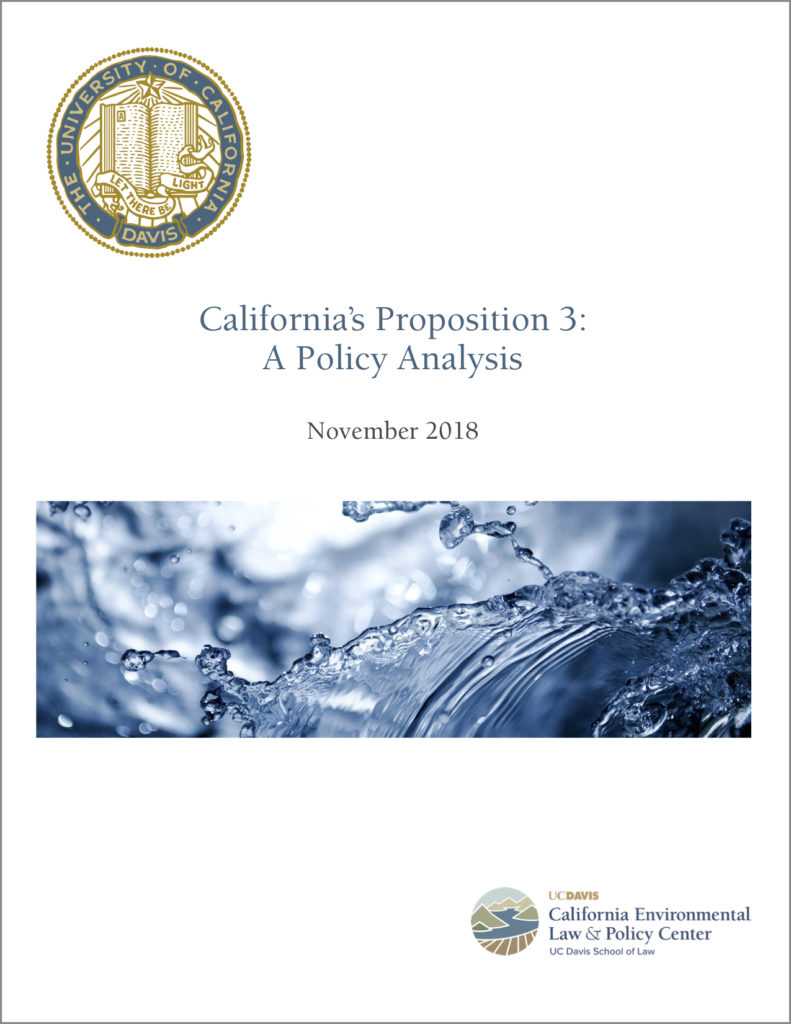U.C. Davis Law’s Environmental Law Center Releases Proposition 3 White Paper
Report Analyzes California’s Newest, Multi-Billion Dollar Water Bond Initiative

The U.C. Davis School of Law’s California Environmental Law & Policy Center has published a detailed analysis of one of the most controversial initiative measures facing California voters on the November 6, 2018 general election ballot: Proposition 3. California’s Proposition 3: A Policy Analysis provides a detailed summary and analysis of the proposed “Water Supply and Water Quality Act of 2018.” If enacted, Proposition 3 would authorize the sale of $8.877 billion in state general obligation bonds to finance a wide array of water infrastructure, safe drinking water, groundwater management and watershed and fisheries improvement projects. (When interest payments are included, the cost to California taxpayers of this proposed water bond measure would be an estimated $17.3 billion.)
The new white paper, authored by 2018-19 CELPC Environmental Law Fellow Sunshine Saldivar (King Hall `17), includes a background discussion on recent California’s state spending on water projects; the impetus for Proposition 3; how this initiative measure was developed and placed on the general election ballot; a detailed explication of the six different categories of water projects that Proposition 3 would fund if passed into law; a discussion of the measure’s key “water justice” component; and a summary of the arguments advanced by both proponents and opponents of Proposition 3.
Supporters of Proposition 3, led by its principal author, Jerry Meral (a former senior water and natural resources advisor to California Governor Jerry Brown and prior executive director of the Planning and Conservation League), argue that investment in California’s crumbling water infrastructure is desperately needed to help secure the state’s future water supply in future years. Proposition 3’s advocates further contend that substantial new funding is required to ensure that California’s disadvantaged communities gain greater access to safe drinking water. Finally, they stress that the proposed bond measure would fund an array of needed environmental benefits for watershed lands and critical fish and wildlife habitat.
Proposition 3’s opponents, on the other hand, have several criticisms of the measure. First, they argue that the initiative measure lacks transparency because the measure was developed and drafted “behind closed doors” and placed on the ballot through the signature-gathering process rather than (as is the case with most bond measures coming before the votes) first being debated and enacted by the California Legislature. A related criticism is that Proposition 3 is a so-called “pay-to-play” measure, because private groups allegedly provided funds to support the initiative’s campaign in exchange for receiving funding from the water bond proceeds. Finally, opponents contend that Proposition 3 would provide taxpayer funding to numerous water infrastructure projects that they believe should instead be paid for by those, like corporate agricultural interests, who stand to benefit directly and disproportionately from those infrastructure projects.
Notably, California’s political leaders, newspaper editorial boards and environmental groups are divided regarding the merits of Proposition 3. Supporting the water bond measure are U.S. Senator Feinstein, State Senate President Pro tem Toni Atkins, newspapers from California’s major agricultural regions and the League of California Cities, California Chamber of Commerce, the Nature Conservancy and Ducks Unlimited. Opponents of Proposition 3 include State Assembly Speaker Anthony Rendon, most of California’s major urban newspapers, the League of Women Voters of California, the Sierra Club, Friends of the River and the Southern California Watershed Alliance.
The full text of Proposition 3 can be found here; the official title, summary and fiscal analysis of the initiative measure, together with formal arguments submitted to voters by designated proponents and opponents of Proposition 3, can be found here.
California’s Proposition 3: A Policy Analysis is not an advocacy document. Rather, CELPC’s goal is to provide a nonpartisan, objective analysis of this major initiative measure in order to better inform California voters and interested observers, and thereby help elevate the public dialogue concerning water and fiscal issues affecting every Californian.





Reader Comments